Abstract
We report the cDNA cloning of SREBP-2, the second member of a family of basic-helix-loop-helix-leucine zipper (bHLH-Zip) transcription factors that recognize sterol regulatory element 1 (SRE-1). SRE-1, a conditional enhancer in the promoters for the low density lipoprotein receptor and 3-hydroxy-3-methylglutaryl-coenzyme A synthase genes, increases transcription in the absence of sterols and is inactivated when sterols accumulate. Human SREBP-2 contains 1141 amino acids and is 47% identical to human SREBP-1a, the first recognized member of this family. The resemblance includes an acidic NH2 terminus, a highly conserved bHLH-Zip motif (71% identical), and an unusually long extension of 740 amino acids on the COOH-terminal side of the bHLH-Zip region. SREBP-2 possesses one feature lacking in SREBP-1a--namely, a glutamine-rich region (27% glutamine over 121 residues). In vitro SREBP-2 bound SRE-1 with the same specificity as SREBP-1a. In vivo it mimicked SREBP-1a in activating transcription of reporter genes containing SRE-1. As with SREBP-1a, activation by SREBP-2 occurred in the absence and presence of sterols, abolishing regulation. Cotransfection of low amounts of pSREBP-1a and pSREBP-2 into human embryonic kidney 293 cells stimulated transcription of promoters containing SRE-1 in an additive fashion. At high levels transcription reached a maximum, and the effects were no longer additive. The reason for the existence of two SREBPs and the mechanism by which they are regulated by sterols remain to be determined.
Full text
PDF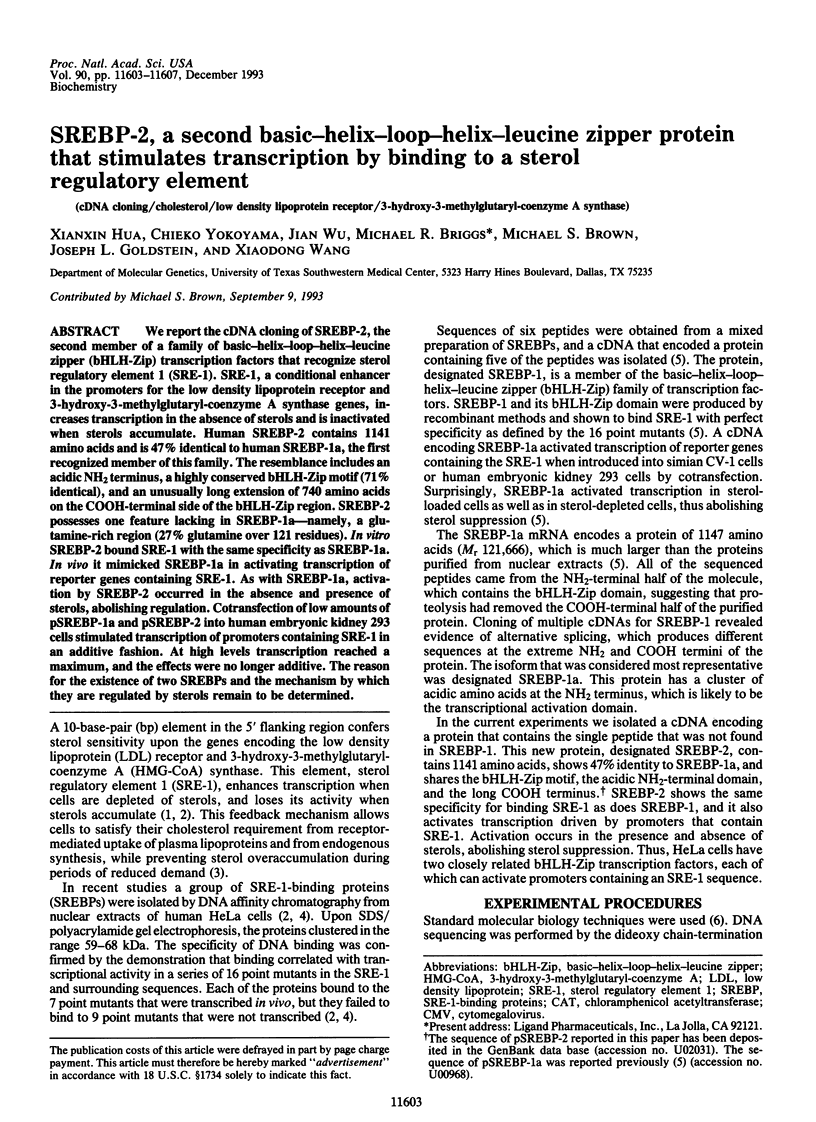
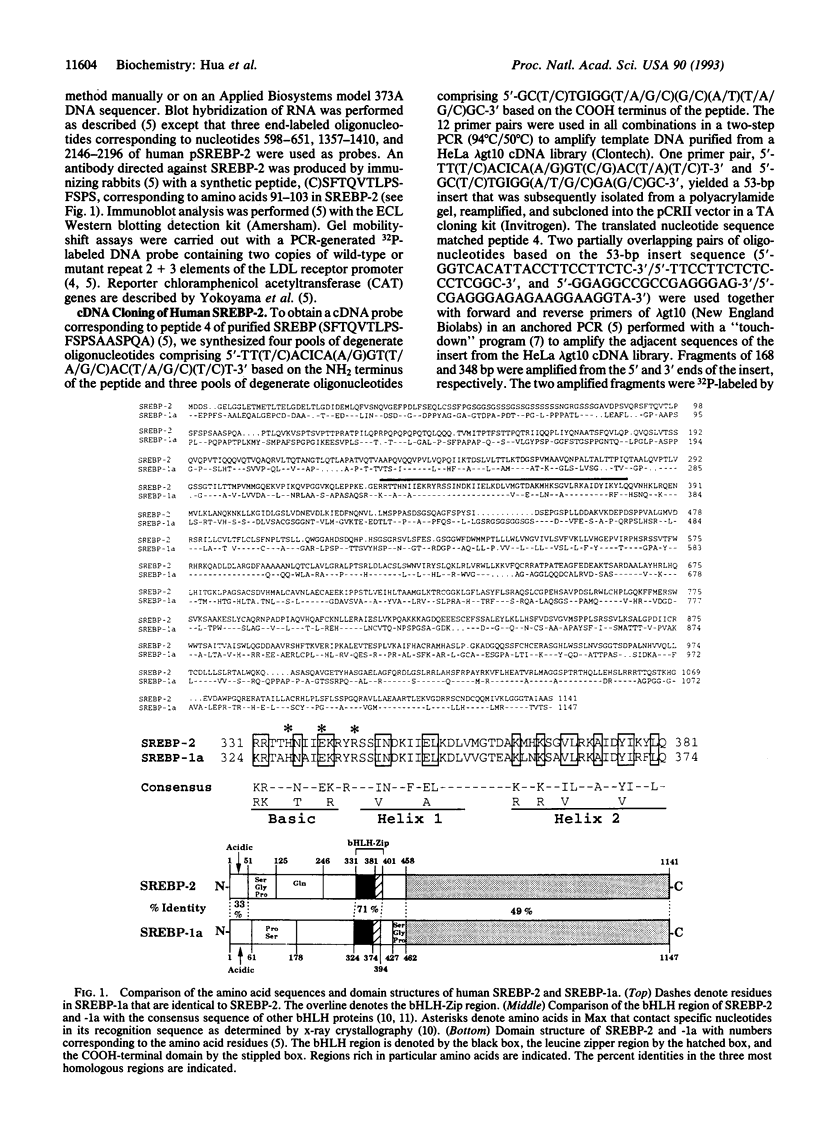
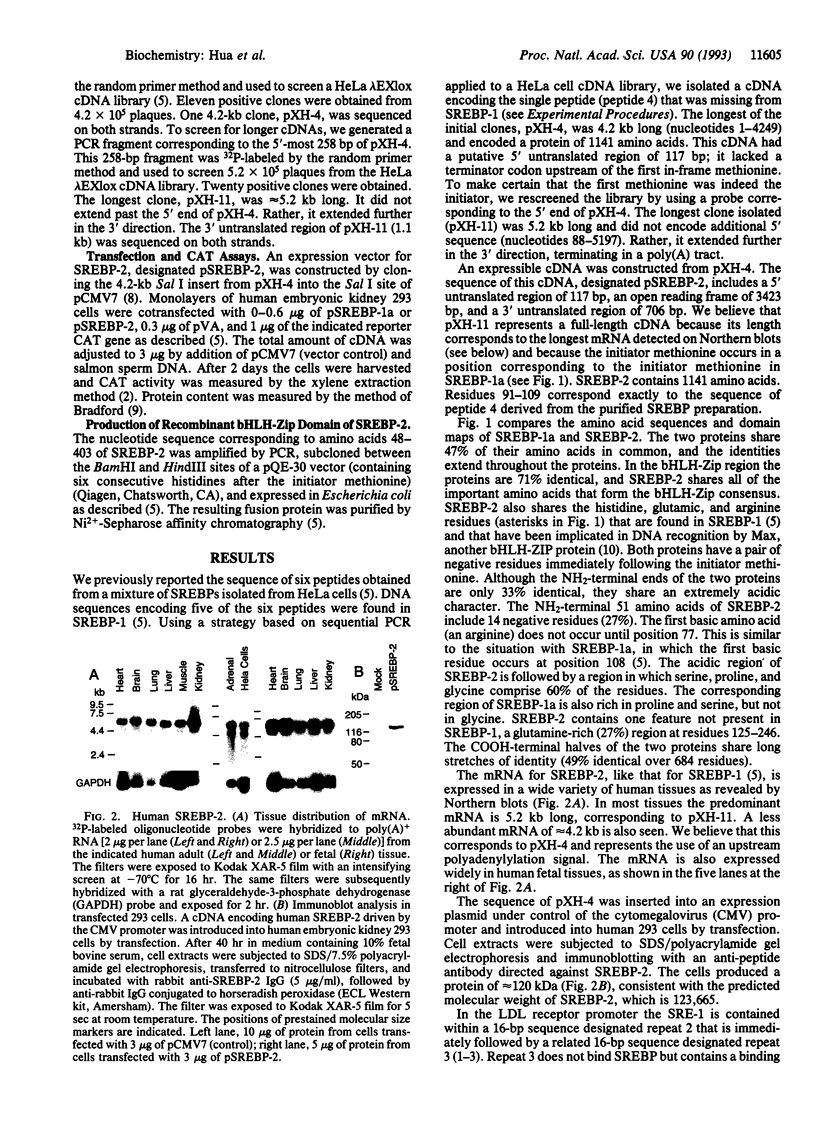
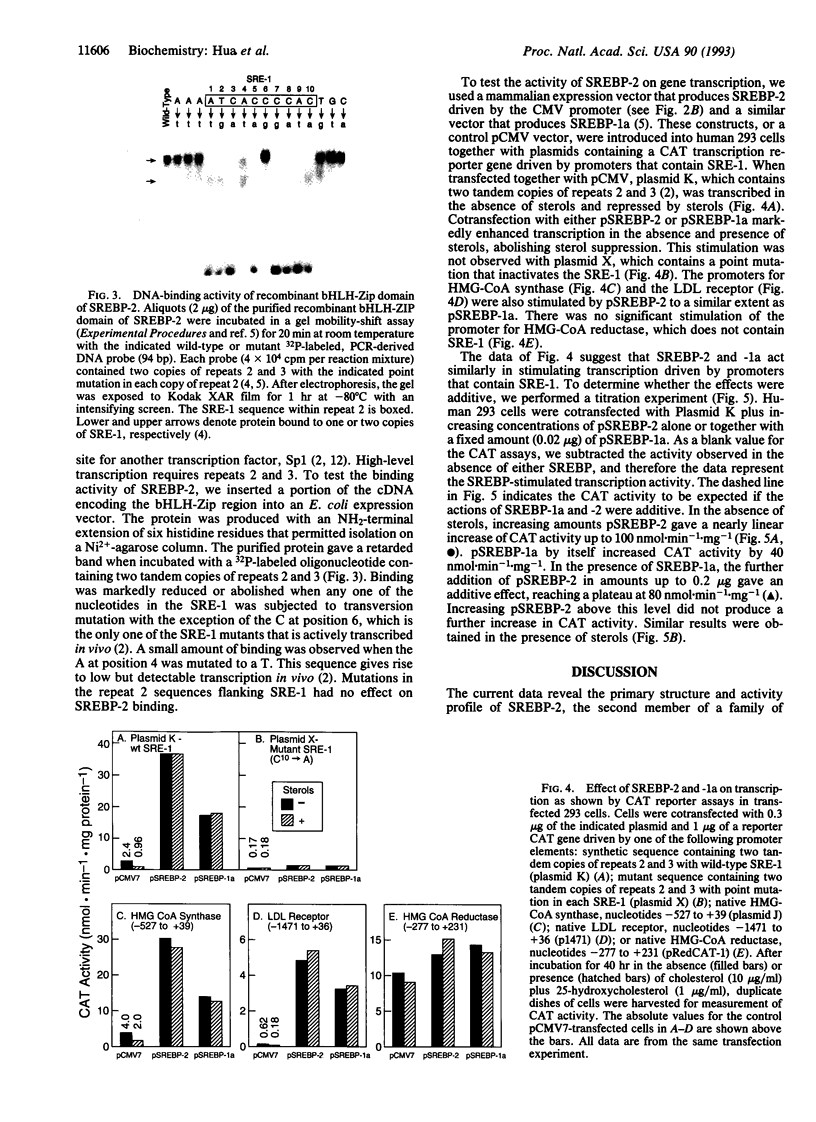
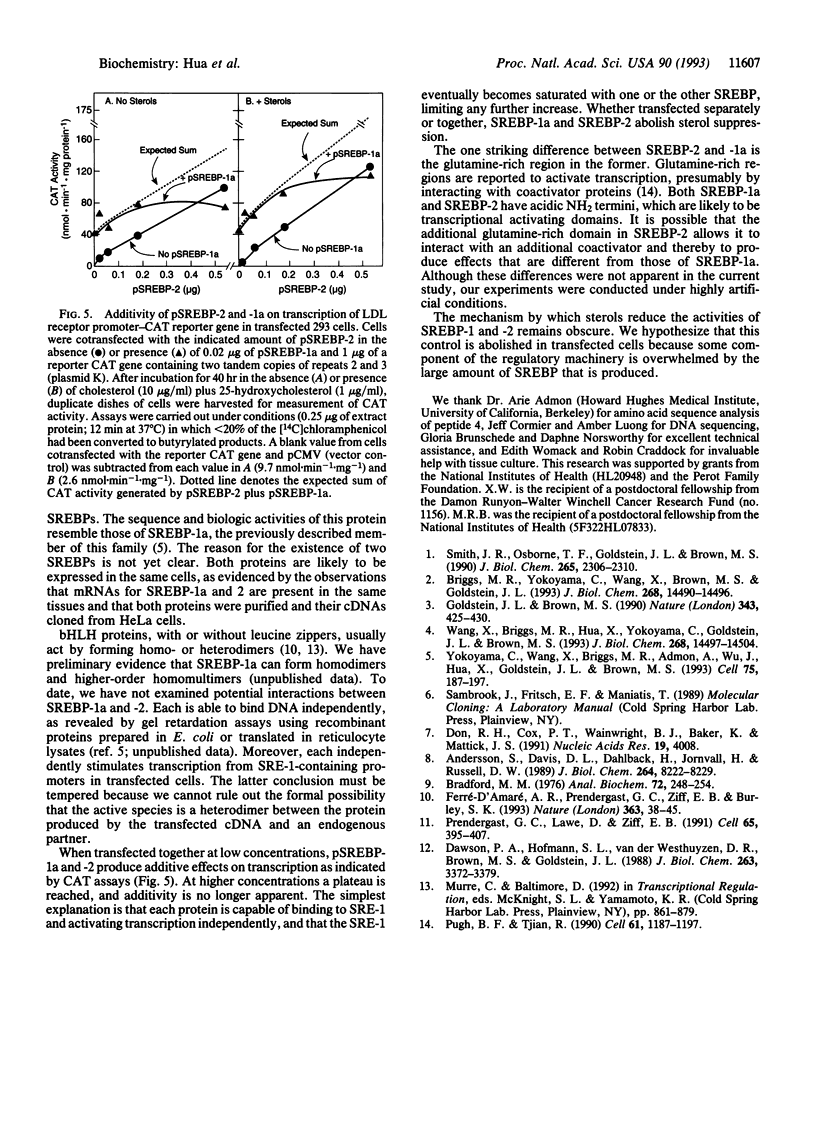
Images in this article
Selected References
These references are in PubMed. This may not be the complete list of references from this article.
- Andersson S., Davis D. L., Dahlbäck H., Jörnvall H., Russell D. W. Cloning, structure, and expression of the mitochondrial cytochrome P-450 sterol 26-hydroxylase, a bile acid biosynthetic enzyme. J Biol Chem. 1989 May 15;264(14):8222–8229. [PubMed] [Google Scholar]
- Bradford M. M. A rapid and sensitive method for the quantitation of microgram quantities of protein utilizing the principle of protein-dye binding. Anal Biochem. 1976 May 7;72:248–254. doi: 10.1016/0003-2697(76)90527-3. [DOI] [PubMed] [Google Scholar]
- Briggs M. R., Yokoyama C., Wang X., Brown M. S., Goldstein J. L. Nuclear protein that binds sterol regulatory element of low density lipoprotein receptor promoter. I. Identification of the protein and delineation of its target nucleotide sequence. J Biol Chem. 1993 Jul 5;268(19):14490–14496. [PubMed] [Google Scholar]
- Dawson P. A., Hofmann S. L., van der Westhuyzen D. R., Südhof T. C., Brown M. S., Goldstein J. L. Sterol-dependent repression of low density lipoprotein receptor promoter mediated by 16-base pair sequence adjacent to binding site for transcription factor Sp1. J Biol Chem. 1988 Mar 5;263(7):3372–3379. [PubMed] [Google Scholar]
- Don R. H., Cox P. T., Wainwright B. J., Baker K., Mattick J. S. 'Touchdown' PCR to circumvent spurious priming during gene amplification. Nucleic Acids Res. 1991 Jul 25;19(14):4008–4008. doi: 10.1093/nar/19.14.4008. [DOI] [PMC free article] [PubMed] [Google Scholar]
- Ferré-D'Amaré A. R., Prendergast G. C., Ziff E. B., Burley S. K. Recognition by Max of its cognate DNA through a dimeric b/HLH/Z domain. Nature. 1993 May 6;363(6424):38–45. doi: 10.1038/363038a0. [DOI] [PubMed] [Google Scholar]
- Goldstein J. L., Brown M. S. Regulation of the mevalonate pathway. Nature. 1990 Feb 1;343(6257):425–430. doi: 10.1038/343425a0. [DOI] [PubMed] [Google Scholar]
- Prendergast G. C., Lawe D., Ziff E. B. Association of Myn, the murine homolog of max, with c-Myc stimulates methylation-sensitive DNA binding and ras cotransformation. Cell. 1991 May 3;65(3):395–407. doi: 10.1016/0092-8674(91)90457-a. [DOI] [PubMed] [Google Scholar]
- Pugh B. F., Tjian R. Mechanism of transcriptional activation by Sp1: evidence for coactivators. Cell. 1990 Jun 29;61(7):1187–1197. doi: 10.1016/0092-8674(90)90683-6. [DOI] [PubMed] [Google Scholar]
- Smith J. R., Osborne T. F., Goldstein J. L., Brown M. S. Identification of nucleotides responsible for enhancer activity of sterol regulatory element in low density lipoprotein receptor gene. J Biol Chem. 1990 Feb 5;265(4):2306–2310. [PubMed] [Google Scholar]
- Wang X., Briggs M. R., Hua X., Yokoyama C., Goldstein J. L., Brown M. S. Nuclear protein that binds sterol regulatory element of low density lipoprotein receptor promoter. II. Purification and characterization. J Biol Chem. 1993 Jul 5;268(19):14497–14504. [PubMed] [Google Scholar]
- Yokoyama C., Wang X., Briggs M. R., Admon A., Wu J., Hua X., Goldstein J. L., Brown M. S. SREBP-1, a basic-helix-loop-helix-leucine zipper protein that controls transcription of the low density lipoprotein receptor gene. Cell. 1993 Oct 8;75(1):187–197. [PubMed] [Google Scholar]




